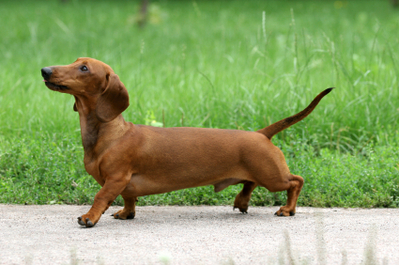The very physical attributes that make them unique are also the source of many Dachshund back problems. Like other long-bodied dogs, Dachshunds face injury from jumping, excessive stair-climbing, and other high-impact activities. Careless breeding of dogs without health screenings also results in higher rates of genetic diseases passed down to puppies. And an increasing number of dogs (and cats) are overweight in America today, a condition that puts a special strain on a Dashchund’s long back.

Pulsed Electromagnetic Field (PEMF) Therapy is a promising alternative and/or supplement to the medications and surgical interventions that are used to treat Dachshund back problems. PEMF has significant anti-inflammatory activity that can be used in virtually any disorders that emerge from inflammation (see clinical studies and research). The domestic life of Dachshund, who was bred for outdoor hunting, includes many activities (like stair climbing) which produce inflammatory stress on their spines. Treating the areas that are subject to those stresses may reduce the effects of that inflammation. PEMF is not known to have remediating effects on strictly mechanical disorders, such as bone deformities or the like, but is known to reduce the pain and swelling symptoms associated with those deformities, and so significantly improve the quality of life for animals who suffer from those conditions.
Intervertebral disk disease (IVDD) affects more Dachshunds than all other dogs combined and is at the top of the list of Dachshund back problems. IVDD is indicated by herniated disks in the lower back and primarily affects dogs with stunted legs. Affected dogs experience severe pain, usually in the lower back but sometimes in the neck as well. The disease can be treated medically and/or surgically, depending on the severity. Owners can help prevent IVDD by limiting activities that will strain their dog’s backs and spines. In some cases, the Dachshund back problems may be so severe that their rear legs become paralyzed. Carts have been devised to help such dogs get around.
PEMF has been shown in animal models to improve function in animals suffering from spinal disease (see the successful treatment of wobblers disease in Great Danes, as documented by Dr. Tim Crowe). A congenital disease with a genetic component is unlikely to be remediated by PEMF, but PEMF addresses the pain and underlying inflammation, potentially providing significant relief from symptoms. Some studies suggest that PEMF may improve cartilage and slow the rate of loss in other conditions, but has not been verified in IVDD.
Would you like to try the Assisi Loop on Dachshund back problems? Contact us and we can help you talk to your veterinarian about ordering a unit.
